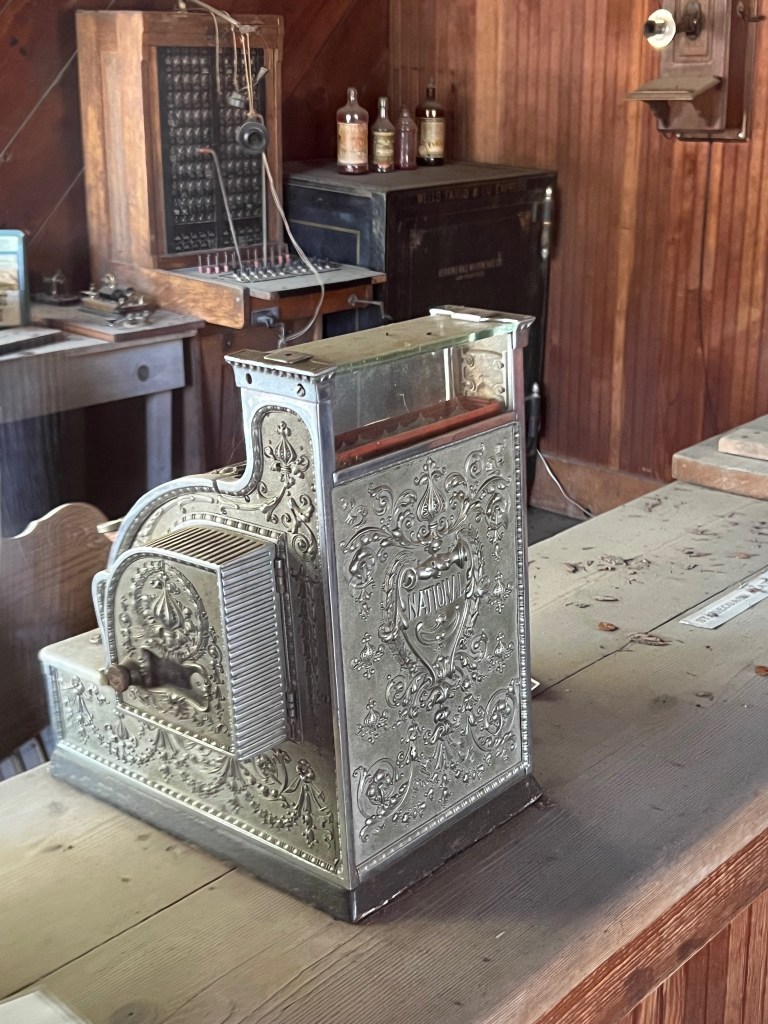You can get pretty tired hiking every day in Yosemite, so my husband and I took a day off to relax and explore. Since we were staying at the Wawona Hotel, we began our day with a terrific breakfast in their restaurant: over-easy eggs, hash browns, and wheat toast for me; poached eggs, avocado, and arugula over wheat toast for my husband. Then we hung out in the lobby catching up on emails, etc. After that, it was time to explore!
The Wawona makes it easy to go exploring–you don’t have to drive anywhere. On the grounds is an artist’s studio/information center and a pioneer history center. First we went to the Wawona Visitor Center at Hill’s Studio.
Artist Thomas Hill
Thomas Hill was an Englishman who moved to the eastern United States at the age of fifteen. He eventually moved to California and became a well-known painter of the California landscape, including Yosemite. During the last twenty-plus years of his life, he spent summers in Wawona as a resident artist. Hill died in 1908. 100 years later, his studio was turned into a visitor center. They have a room dedicated to Thomas Hill’s art. I wish they had more of his paintings on display.


The visitor center within Hill’s studio is very good. It is a compact room, loaded with books and gifts, and staffed by knowledgeable rangers. I bought a few books and asked some questions of the rangers. Then it was on to the next place.
The Pioneer Yosemite History Center
A short path leads down from the Thomas Hill Visitor Center to the Pioneer Yosemite History Center. A beautiful covered bridge over the Merced River leads you into the park. The bridge was built in 1868 and covered in 1878. I enjoyed walking through it, imagining how stage coaches and horse-drawn carriages used to clatter through.




I’ve read that during the summer docents dressed in period costumes staff the Pioneer Yosemite History Center. However, there is no one there the rest of the year. Yet I found it really peaceful and loved exploring the park on my own. None of the buildings were open (an off-season disadvantage), but you could peek through the windows and see original furnishings in a slightly disorganized state. It made it seem more authentic somehow.


The Pioneer History Center is about an acre large and includes historic buildings from the late 19th and early 20th centuries. The buildings were moved to the history center from different spots within Yosemite Park. Each log cabin has a sign in front that explains about the pioneers who lived in each particular building.




I peeked through the window of one old hotel and saw that the inside window frame had visitors’ names, home-locations, and visiting dates carved into it. They weren’t obvious, and very hard to photograph, so I felt like I had made a discovery.


There were many buildings to see in the Pioneer History Center, including this wonderful Grey Barn that used to be the “largest stage stop in Yosemite.”


Before we left Yosemite to return home, I walked down for one last visit to the Pioneer Yosemite History Center. It is really a hidden gem. If you have the time, I recommend visiting it. And be sure to take a few minutes to admire the view of the Merced River near the covered bridge.


I hope you enjoyed this series of blogs on Yosemite in Autumn. Please subscribe to follow more footloose adventures.
Discover more from The Footloose Scribbler
Subscribe to get the latest posts sent to your email.



